Improving Communication Systems: Health and Social Care Report
VerifiedAdded on 2020/07/22
|45
|11089
|198
Report
AI Summary
This report comprehensively examines communication within health and social care, addressing various aspects from identifying communication needs of different groups (service users, families, staff) to proposing improvements for effective communication systems. It explores the effectiveness of existing communication practices, identifies obstacles such as physiological, psychological, and language barriers, and suggests methods to overcome these challenges. The report also delves into partnership working, evaluating communication systems and proposing enhancements for better collaboration. Furthermore, it covers essential features of information sharing agreements, professional development, models of reflective practice, equality, diversity, and inclusion, ethical dilemmas, informed choice, and health, safety, and risk management within the healthcare setting. The report concludes with an evaluation of current practices and recommendations for improvement in all these areas.
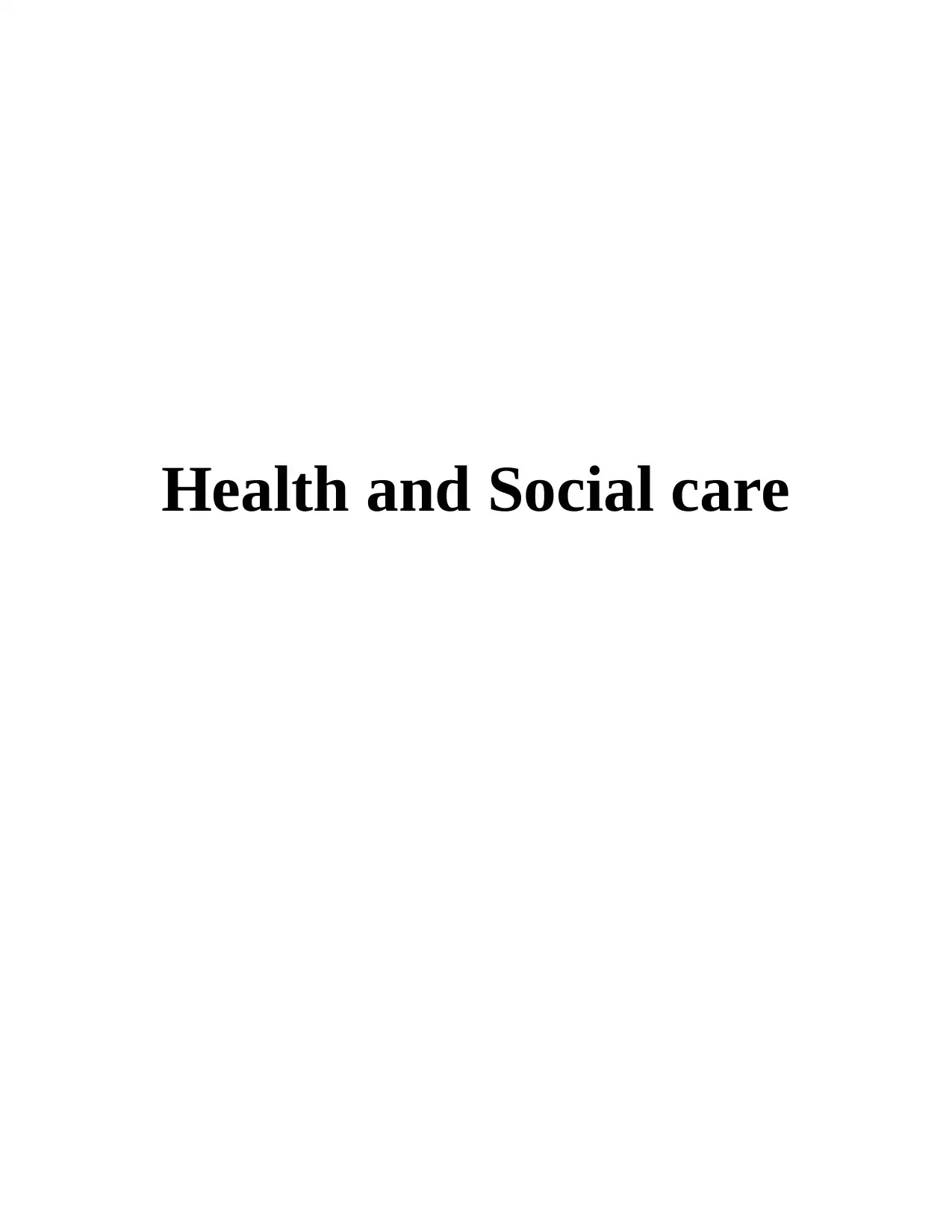
Health and Social care
Paraphrase This Document
Need a fresh take? Get an instant paraphrase of this document with our AI Paraphraser
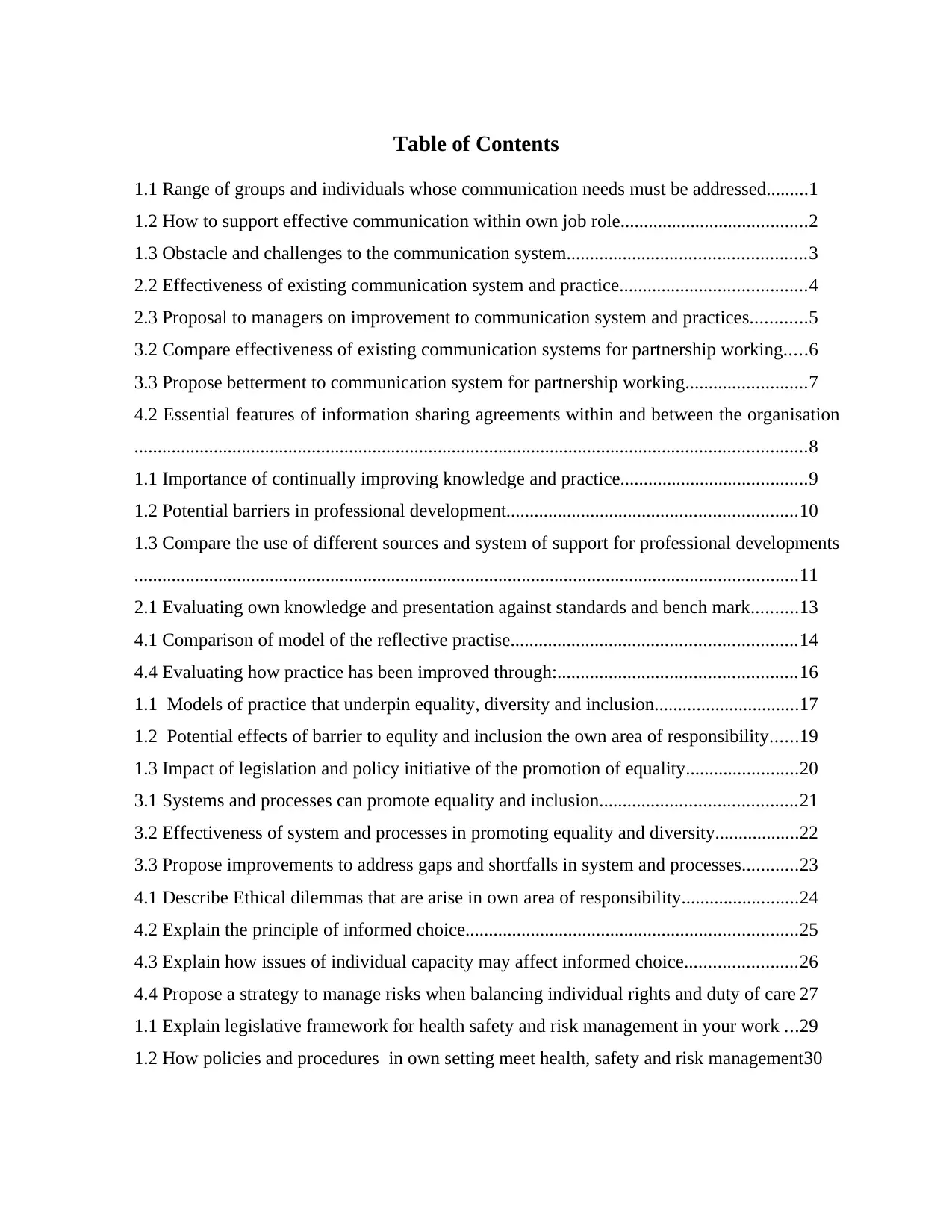
Table of Contents
1.1 Range of groups and individuals whose communication needs must be addressed.........1
1.2 How to support effective communication within own job role........................................2
1.3 Obstacle and challenges to the communication system...................................................3
2.2 Effectiveness of existing communication system and practice........................................4
2.3 Proposal to managers on improvement to communication system and practices............5
3.2 Compare effectiveness of existing communication systems for partnership working.....6
3.3 Propose betterment to communication system for partnership working..........................7
4.2 Essential features of information sharing agreements within and between the organisation
................................................................................................................................................8
1.1 Importance of continually improving knowledge and practice........................................9
1.2 Potential barriers in professional development..............................................................10
1.3 Compare the use of different sources and system of support for professional developments
..............................................................................................................................................11
2.1 Evaluating own knowledge and presentation against standards and bench mark..........13
4.1 Comparison of model of the reflective practise.............................................................14
4.4 Evaluating how practice has been improved through:...................................................16
1.1 Models of practice that underpin equality, diversity and inclusion...............................17
1.2 Potential effects of barrier to equlity and inclusion the own area of responsibility......19
1.3 Impact of legislation and policy initiative of the promotion of equality........................20
3.1 Systems and processes can promote equality and inclusion..........................................21
3.2 Effectiveness of system and processes in promoting equality and diversity..................22
3.3 Propose improvements to address gaps and shortfalls in system and processes............23
4.1 Describe Ethical dilemmas that are arise in own area of responsibility.........................24
4.2 Explain the principle of informed choice.......................................................................25
4.3 Explain how issues of individual capacity may affect informed choice........................26
4.4 Propose a strategy to manage risks when balancing individual rights and duty of care 27
1.1 Explain legislative framework for health safety and risk management in your work ...29
1.2 How policies and procedures in own setting meet health, safety and risk management30
1.1 Range of groups and individuals whose communication needs must be addressed.........1
1.2 How to support effective communication within own job role........................................2
1.3 Obstacle and challenges to the communication system...................................................3
2.2 Effectiveness of existing communication system and practice........................................4
2.3 Proposal to managers on improvement to communication system and practices............5
3.2 Compare effectiveness of existing communication systems for partnership working.....6
3.3 Propose betterment to communication system for partnership working..........................7
4.2 Essential features of information sharing agreements within and between the organisation
................................................................................................................................................8
1.1 Importance of continually improving knowledge and practice........................................9
1.2 Potential barriers in professional development..............................................................10
1.3 Compare the use of different sources and system of support for professional developments
..............................................................................................................................................11
2.1 Evaluating own knowledge and presentation against standards and bench mark..........13
4.1 Comparison of model of the reflective practise.............................................................14
4.4 Evaluating how practice has been improved through:...................................................16
1.1 Models of practice that underpin equality, diversity and inclusion...............................17
1.2 Potential effects of barrier to equlity and inclusion the own area of responsibility......19
1.3 Impact of legislation and policy initiative of the promotion of equality........................20
3.1 Systems and processes can promote equality and inclusion..........................................21
3.2 Effectiveness of system and processes in promoting equality and diversity..................22
3.3 Propose improvements to address gaps and shortfalls in system and processes............23
4.1 Describe Ethical dilemmas that are arise in own area of responsibility.........................24
4.2 Explain the principle of informed choice.......................................................................25
4.3 Explain how issues of individual capacity may affect informed choice........................26
4.4 Propose a strategy to manage risks when balancing individual rights and duty of care 27
1.1 Explain legislative framework for health safety and risk management in your work ...29
1.2 How policies and procedures in own setting meet health, safety and risk management30
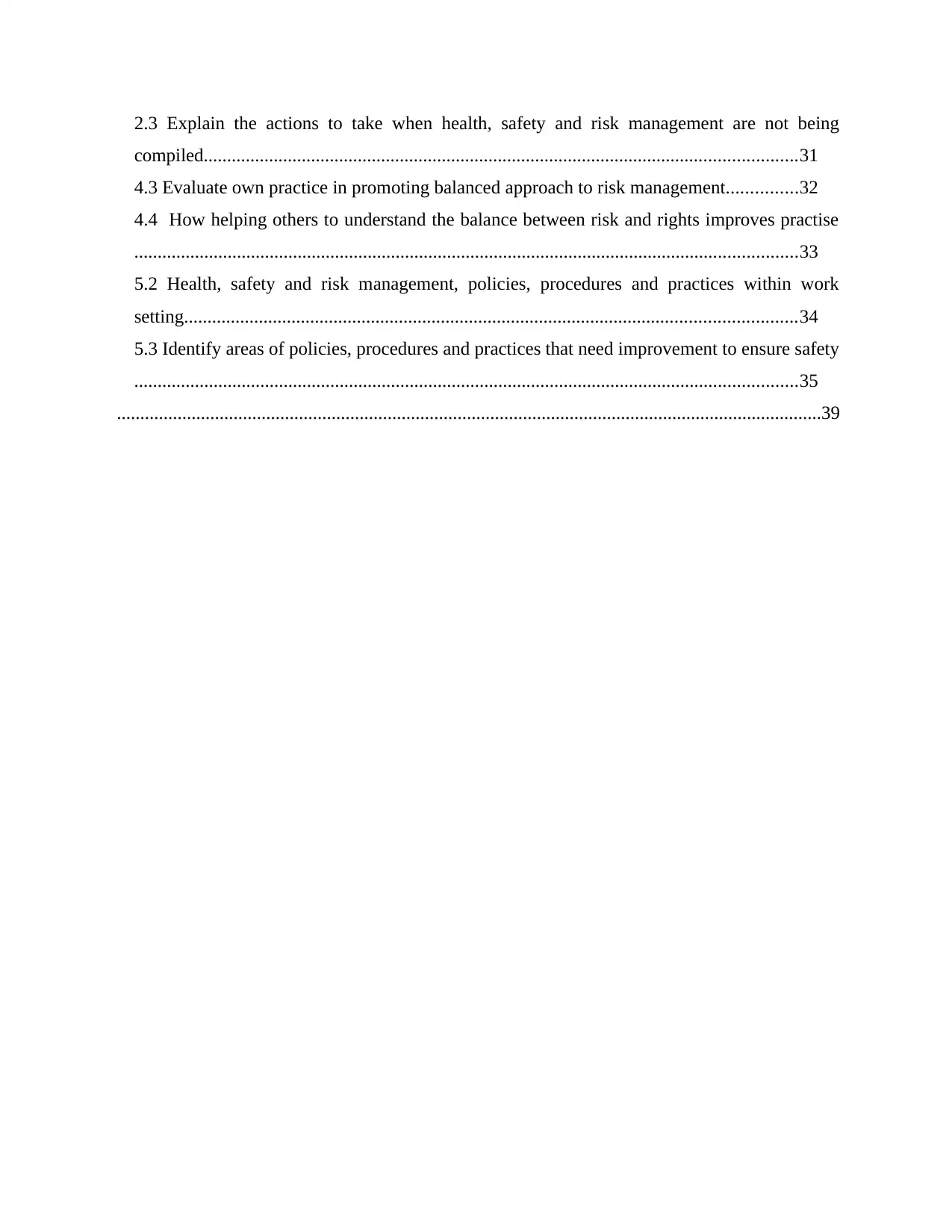
2.3 Explain the actions to take when health, safety and risk management are not being
compiled...............................................................................................................................31
4.3 Evaluate own practice in promoting balanced approach to risk management...............32
4.4 How helping others to understand the balance between risk and rights improves practise
..............................................................................................................................................33
5.2 Health, safety and risk management, policies, procedures and practices within work
setting...................................................................................................................................34
5.3 Identify areas of policies, procedures and practices that need improvement to ensure safety
..............................................................................................................................................35
.......................................................................................................................................................39
compiled...............................................................................................................................31
4.3 Evaluate own practice in promoting balanced approach to risk management...............32
4.4 How helping others to understand the balance between risk and rights improves practise
..............................................................................................................................................33
5.2 Health, safety and risk management, policies, procedures and practices within work
setting...................................................................................................................................34
5.3 Identify areas of policies, procedures and practices that need improvement to ensure safety
..............................................................................................................................................35
.......................................................................................................................................................39
⊘ This is a preview!⊘
Do you want full access?
Subscribe today to unlock all pages.

Trusted by 1+ million students worldwide
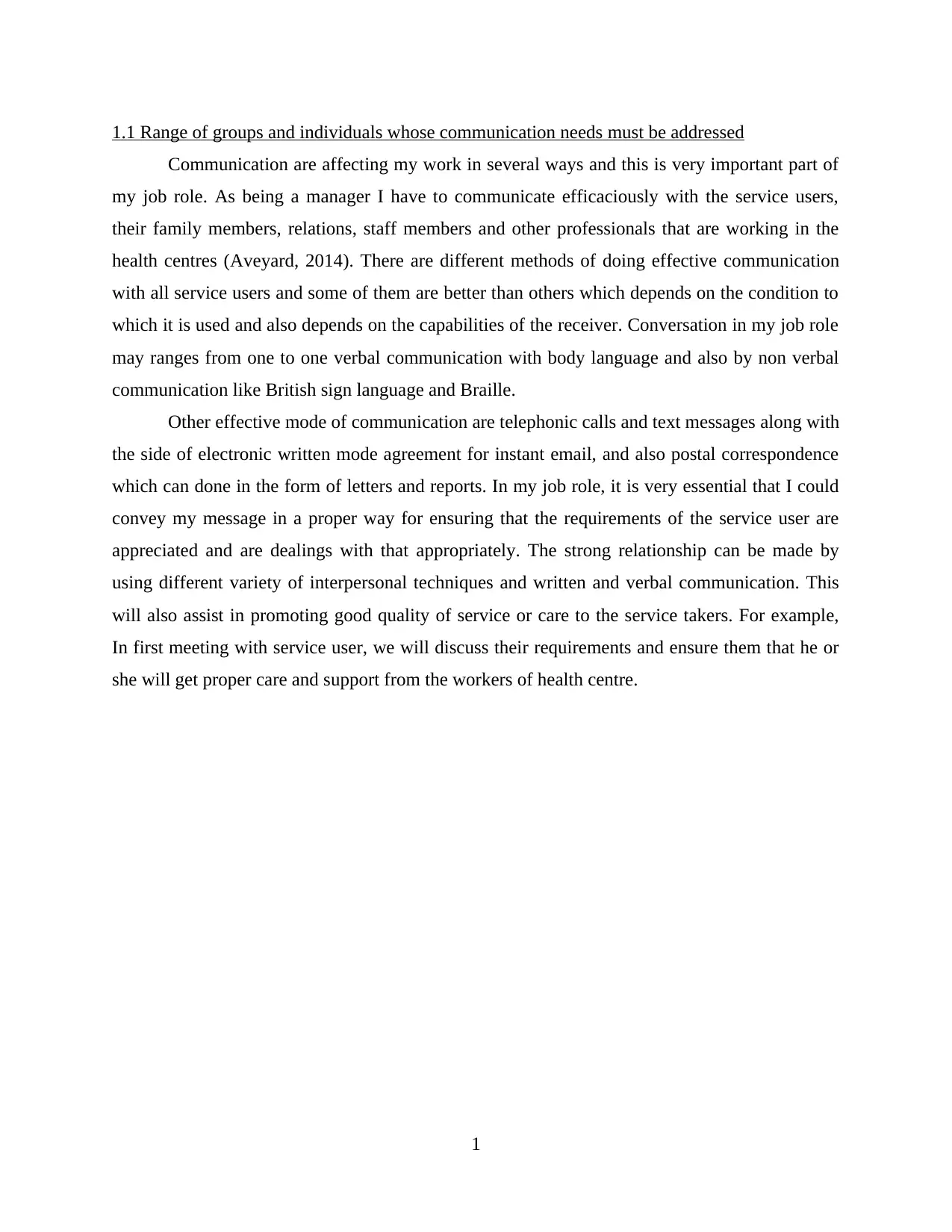
1.1 Range of groups and individuals whose communication needs must be addressed
Communication are affecting my work in several ways and this is very important part of
my job role. As being a manager I have to communicate efficaciously with the service users,
their family members, relations, staff members and other professionals that are working in the
health centres (Aveyard, 2014). There are different methods of doing effective communication
with all service users and some of them are better than others which depends on the condition to
which it is used and also depends on the capabilities of the receiver. Conversation in my job role
may ranges from one to one verbal communication with body language and also by non verbal
communication like British sign language and Braille.
Other effective mode of communication are telephonic calls and text messages along with
the side of electronic written mode agreement for instant email, and also postal correspondence
which can done in the form of letters and reports. In my job role, it is very essential that I could
convey my message in a proper way for ensuring that the requirements of the service user are
appreciated and are dealings with that appropriately. The strong relationship can be made by
using different variety of interpersonal techniques and written and verbal communication. This
will also assist in promoting good quality of service or care to the service takers. For example,
In first meeting with service user, we will discuss their requirements and ensure them that he or
she will get proper care and support from the workers of health centre.
1
Communication are affecting my work in several ways and this is very important part of
my job role. As being a manager I have to communicate efficaciously with the service users,
their family members, relations, staff members and other professionals that are working in the
health centres (Aveyard, 2014). There are different methods of doing effective communication
with all service users and some of them are better than others which depends on the condition to
which it is used and also depends on the capabilities of the receiver. Conversation in my job role
may ranges from one to one verbal communication with body language and also by non verbal
communication like British sign language and Braille.
Other effective mode of communication are telephonic calls and text messages along with
the side of electronic written mode agreement for instant email, and also postal correspondence
which can done in the form of letters and reports. In my job role, it is very essential that I could
convey my message in a proper way for ensuring that the requirements of the service user are
appreciated and are dealings with that appropriately. The strong relationship can be made by
using different variety of interpersonal techniques and written and verbal communication. This
will also assist in promoting good quality of service or care to the service takers. For example,
In first meeting with service user, we will discuss their requirements and ensure them that he or
she will get proper care and support from the workers of health centre.
1
Paraphrase This Document
Need a fresh take? Get an instant paraphrase of this document with our AI Paraphraser
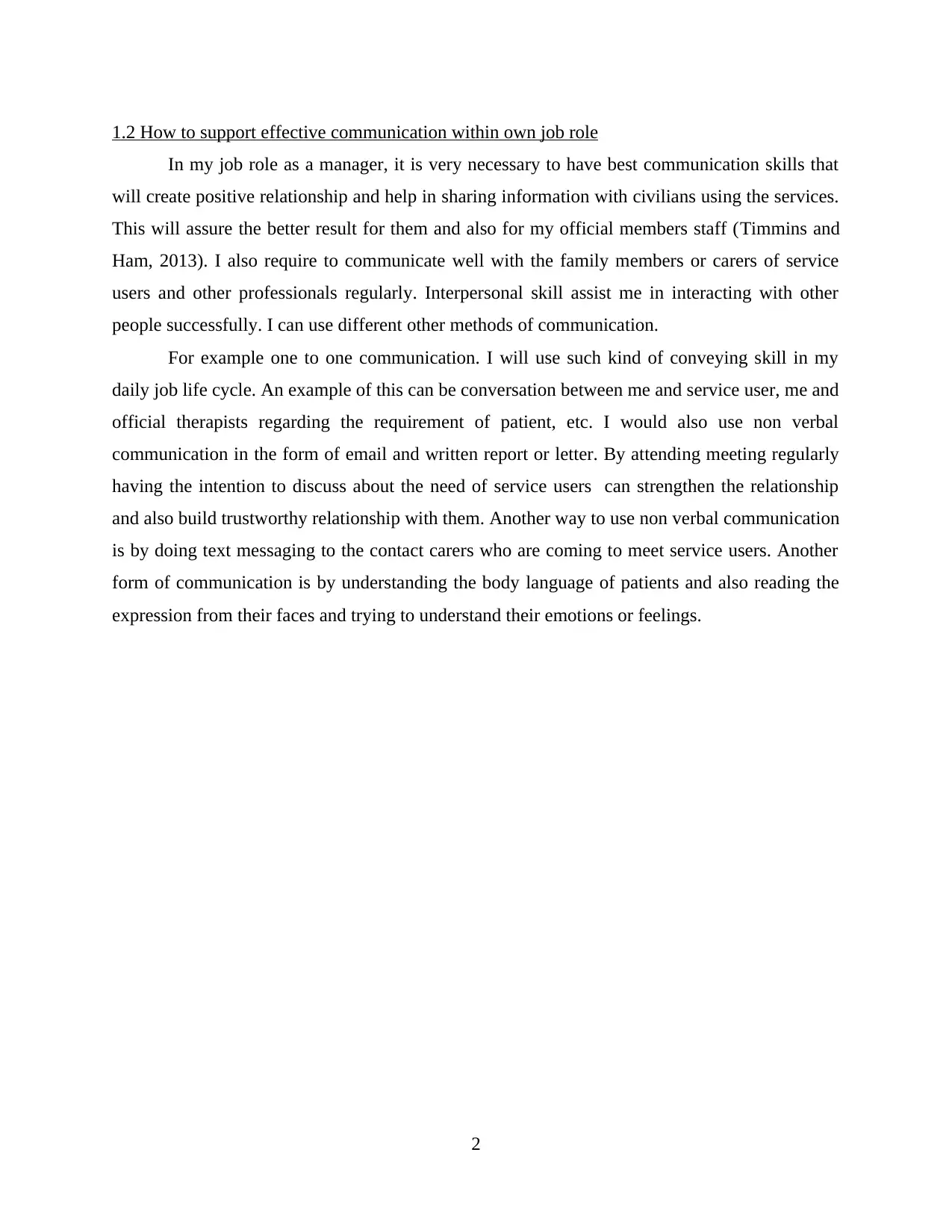
1.2 How to support effective communication within own job role
In my job role as a manager, it is very necessary to have best communication skills that
will create positive relationship and help in sharing information with civilians using the services.
This will assure the better result for them and also for my official members staff (Timmins and
Ham, 2013). I also require to communicate well with the family members or carers of service
users and other professionals regularly. Interpersonal skill assist me in interacting with other
people successfully. I can use different other methods of communication.
For example one to one communication. I will use such kind of conveying skill in my
daily job life cycle. An example of this can be conversation between me and service user, me and
official therapists regarding the requirement of patient, etc. I would also use non verbal
communication in the form of email and written report or letter. By attending meeting regularly
having the intention to discuss about the need of service users can strengthen the relationship
and also build trustworthy relationship with them. Another way to use non verbal communication
is by doing text messaging to the contact carers who are coming to meet service users. Another
form of communication is by understanding the body language of patients and also reading the
expression from their faces and trying to understand their emotions or feelings.
2
In my job role as a manager, it is very necessary to have best communication skills that
will create positive relationship and help in sharing information with civilians using the services.
This will assure the better result for them and also for my official members staff (Timmins and
Ham, 2013). I also require to communicate well with the family members or carers of service
users and other professionals regularly. Interpersonal skill assist me in interacting with other
people successfully. I can use different other methods of communication.
For example one to one communication. I will use such kind of conveying skill in my
daily job life cycle. An example of this can be conversation between me and service user, me and
official therapists regarding the requirement of patient, etc. I would also use non verbal
communication in the form of email and written report or letter. By attending meeting regularly
having the intention to discuss about the need of service users can strengthen the relationship
and also build trustworthy relationship with them. Another way to use non verbal communication
is by doing text messaging to the contact carers who are coming to meet service users. Another
form of communication is by understanding the body language of patients and also reading the
expression from their faces and trying to understand their emotions or feelings.
2
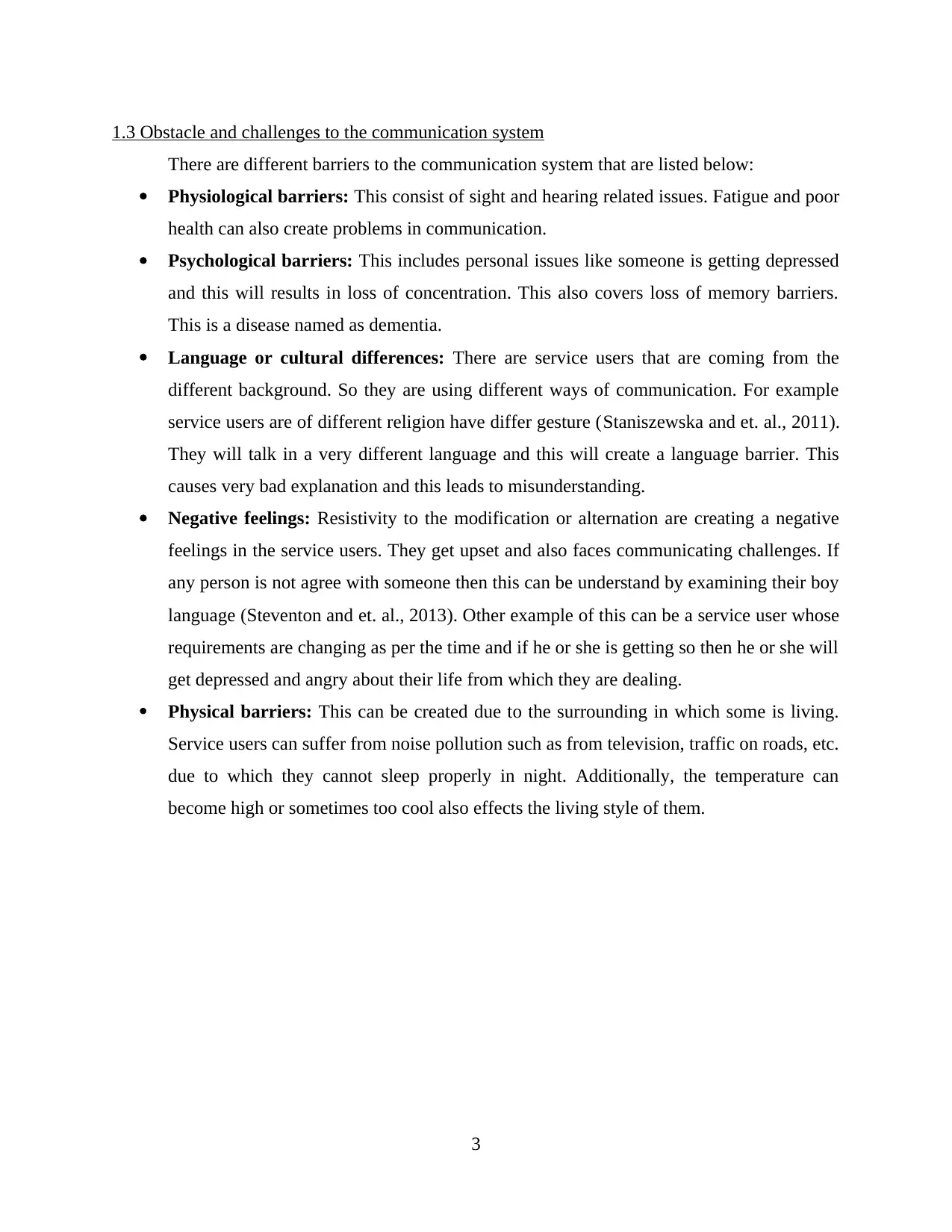
1.3 Obstacle and challenges to the communication system
There are different barriers to the communication system that are listed below:
Physiological barriers: This consist of sight and hearing related issues. Fatigue and poor
health can also create problems in communication.
Psychological barriers: This includes personal issues like someone is getting depressed
and this will results in loss of concentration. This also covers loss of memory barriers.
This is a disease named as dementia.
Language or cultural differences: There are service users that are coming from the
different background. So they are using different ways of communication. For example
service users are of different religion have differ gesture (Staniszewska and et. al., 2011).
They will talk in a very different language and this will create a language barrier. This
causes very bad explanation and this leads to misunderstanding.
Negative feelings: Resistivity to the modification or alternation are creating a negative
feelings in the service users. They get upset and also faces communicating challenges. If
any person is not agree with someone then this can be understand by examining their boy
language (Steventon and et. al., 2013). Other example of this can be a service user whose
requirements are changing as per the time and if he or she is getting so then he or she will
get depressed and angry about their life from which they are dealing.
Physical barriers: This can be created due to the surrounding in which some is living.
Service users can suffer from noise pollution such as from television, traffic on roads, etc.
due to which they cannot sleep properly in night. Additionally, the temperature can
become high or sometimes too cool also effects the living style of them.
3
There are different barriers to the communication system that are listed below:
Physiological barriers: This consist of sight and hearing related issues. Fatigue and poor
health can also create problems in communication.
Psychological barriers: This includes personal issues like someone is getting depressed
and this will results in loss of concentration. This also covers loss of memory barriers.
This is a disease named as dementia.
Language or cultural differences: There are service users that are coming from the
different background. So they are using different ways of communication. For example
service users are of different religion have differ gesture (Staniszewska and et. al., 2011).
They will talk in a very different language and this will create a language barrier. This
causes very bad explanation and this leads to misunderstanding.
Negative feelings: Resistivity to the modification or alternation are creating a negative
feelings in the service users. They get upset and also faces communicating challenges. If
any person is not agree with someone then this can be understand by examining their boy
language (Steventon and et. al., 2013). Other example of this can be a service user whose
requirements are changing as per the time and if he or she is getting so then he or she will
get depressed and angry about their life from which they are dealing.
Physical barriers: This can be created due to the surrounding in which some is living.
Service users can suffer from noise pollution such as from television, traffic on roads, etc.
due to which they cannot sleep properly in night. Additionally, the temperature can
become high or sometimes too cool also effects the living style of them.
3
⊘ This is a preview!⊘
Do you want full access?
Subscribe today to unlock all pages.

Trusted by 1+ million students worldwide
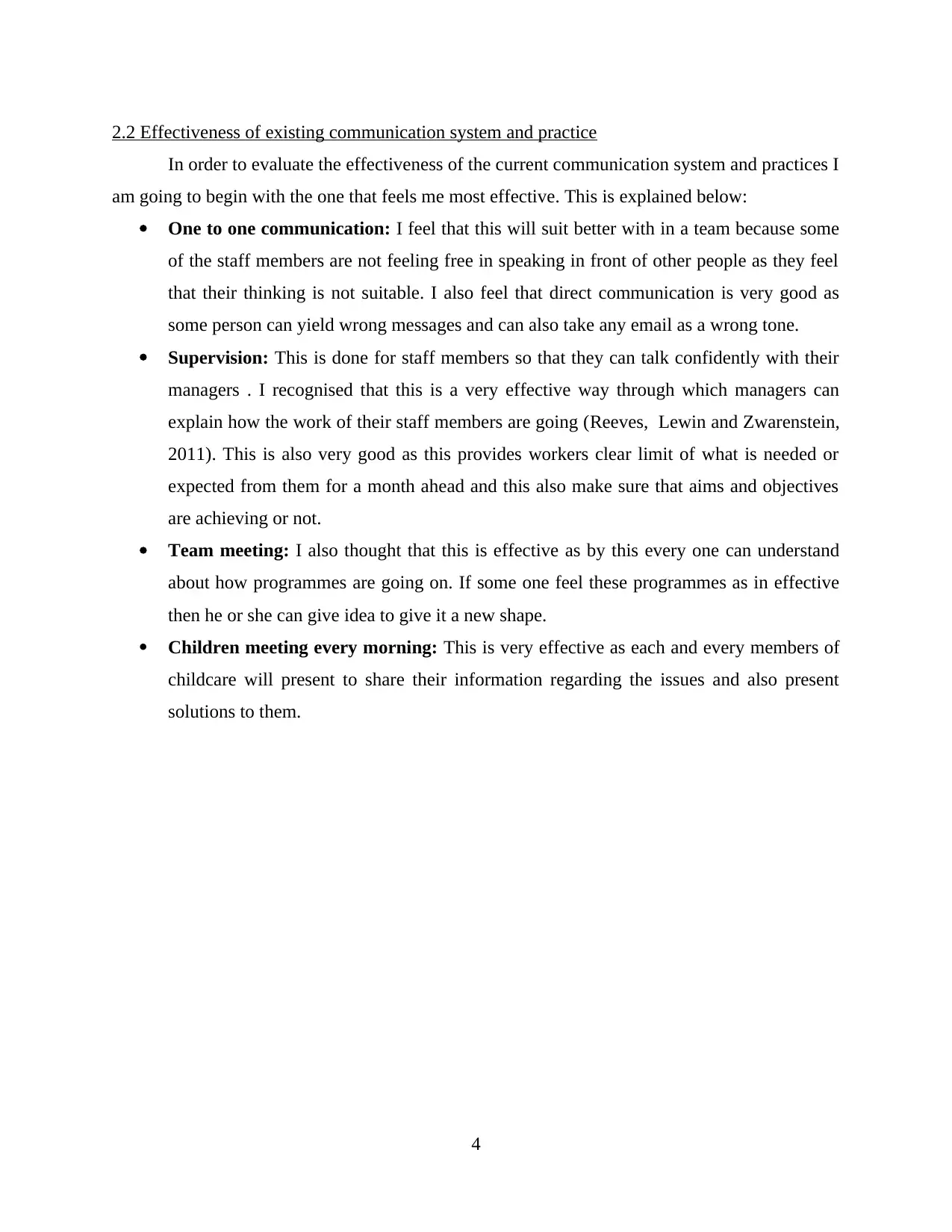
2.2 Effectiveness of existing communication system and practice
In order to evaluate the effectiveness of the current communication system and practices I
am going to begin with the one that feels me most effective. This is explained below:
One to one communication: I feel that this will suit better with in a team because some
of the staff members are not feeling free in speaking in front of other people as they feel
that their thinking is not suitable. I also feel that direct communication is very good as
some person can yield wrong messages and can also take any email as a wrong tone.
Supervision: This is done for staff members so that they can talk confidently with their
managers . I recognised that this is a very effective way through which managers can
explain how the work of their staff members are going (Reeves, Lewin and Zwarenstein,
2011). This is also very good as this provides workers clear limit of what is needed or
expected from them for a month ahead and this also make sure that aims and objectives
are achieving or not.
Team meeting: I also thought that this is effective as by this every one can understand
about how programmes are going on. If some one feel these programmes as in effective
then he or she can give idea to give it a new shape.
Children meeting every morning: This is very effective as each and every members of
childcare will present to share their information regarding the issues and also present
solutions to them.
4
In order to evaluate the effectiveness of the current communication system and practices I
am going to begin with the one that feels me most effective. This is explained below:
One to one communication: I feel that this will suit better with in a team because some
of the staff members are not feeling free in speaking in front of other people as they feel
that their thinking is not suitable. I also feel that direct communication is very good as
some person can yield wrong messages and can also take any email as a wrong tone.
Supervision: This is done for staff members so that they can talk confidently with their
managers . I recognised that this is a very effective way through which managers can
explain how the work of their staff members are going (Reeves, Lewin and Zwarenstein,
2011). This is also very good as this provides workers clear limit of what is needed or
expected from them for a month ahead and this also make sure that aims and objectives
are achieving or not.
Team meeting: I also thought that this is effective as by this every one can understand
about how programmes are going on. If some one feel these programmes as in effective
then he or she can give idea to give it a new shape.
Children meeting every morning: This is very effective as each and every members of
childcare will present to share their information regarding the issues and also present
solutions to them.
4
Paraphrase This Document
Need a fresh take? Get an instant paraphrase of this document with our AI Paraphraser

2.3 Proposal to managers on improvement to communication system and practices
Communication system are different processes by which data can be transfferd betwneen
managers and employees within an organisation. Communication can be written, verbal, non
verbal, electronic, etc. The communication system can be improved by using the following ways
and methods:
Encouraging open feedback: If proper information is the key to do effective
communication then corporation of health and social care have to encourage the
feedbacks from the service users (Oven and et. al., 2012). After all this is the primary
source of communication. But there are some risky factors such as employees gets
shocked of the repercussions that they will face when their work get extremely open in
front of supervisors. Similarly, high ranked officials may be some what perceptive about
hearing what is actually in the brain of employee. In other words, person in enterprises
may be disinclined to provide and get feedbacks.
Using simple language: The communication can be effectively improved by using the
simple and clear languages. As this assist individual to understand the information of the
others. However, at the time of addressing the audiences having the members who are
not familiar with the specific language, then simple and straight forward language is
proved to be more effective.
Avoid overload: Imagine this scene: If some one is doing late night work at the ending
of the term. Also he has to write a paper and prepare for finals simultaneously.
Additionally, he has to do the office work then how will he manage? This will create an
issue of misunderstanding as he will not be able to understand the words of other because
of as much load of work (Munn-Giddings and Winter, 2013). On the contrary, when
some one is free and come to the company in a fresh mind then he or she will understand
most effectively the words or feeling of others. So, managers of health centres should
give low work load to their workers.
Be a good listener: Effective communication also includes more than just representing
messages appropriately. It also consist of listening to the others carefully.
5
Communication system are different processes by which data can be transfferd betwneen
managers and employees within an organisation. Communication can be written, verbal, non
verbal, electronic, etc. The communication system can be improved by using the following ways
and methods:
Encouraging open feedback: If proper information is the key to do effective
communication then corporation of health and social care have to encourage the
feedbacks from the service users (Oven and et. al., 2012). After all this is the primary
source of communication. But there are some risky factors such as employees gets
shocked of the repercussions that they will face when their work get extremely open in
front of supervisors. Similarly, high ranked officials may be some what perceptive about
hearing what is actually in the brain of employee. In other words, person in enterprises
may be disinclined to provide and get feedbacks.
Using simple language: The communication can be effectively improved by using the
simple and clear languages. As this assist individual to understand the information of the
others. However, at the time of addressing the audiences having the members who are
not familiar with the specific language, then simple and straight forward language is
proved to be more effective.
Avoid overload: Imagine this scene: If some one is doing late night work at the ending
of the term. Also he has to write a paper and prepare for finals simultaneously.
Additionally, he has to do the office work then how will he manage? This will create an
issue of misunderstanding as he will not be able to understand the words of other because
of as much load of work (Munn-Giddings and Winter, 2013). On the contrary, when
some one is free and come to the company in a fresh mind then he or she will understand
most effectively the words or feeling of others. So, managers of health centres should
give low work load to their workers.
Be a good listener: Effective communication also includes more than just representing
messages appropriately. It also consist of listening to the others carefully.
5
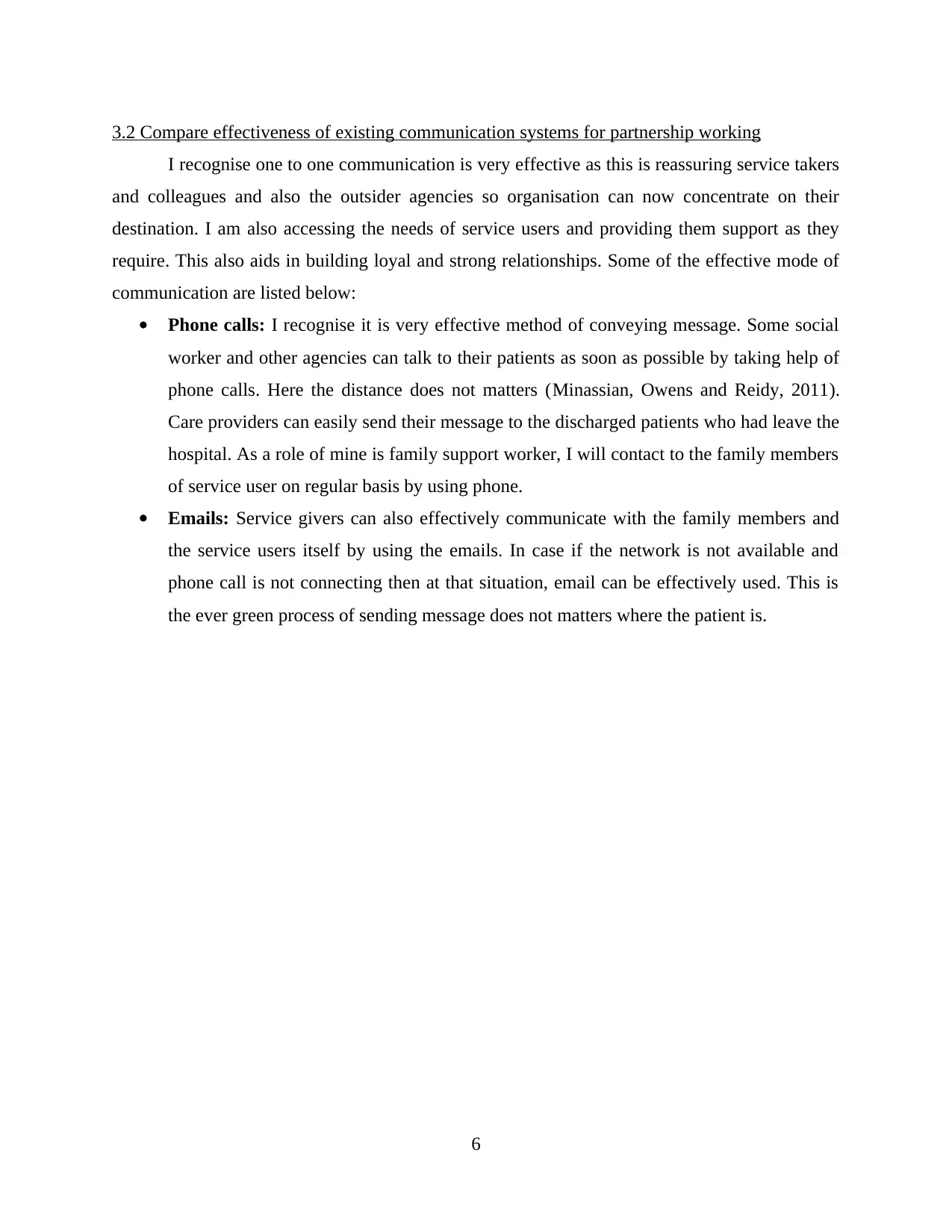
3.2 Compare effectiveness of existing communication systems for partnership working
I recognise one to one communication is very effective as this is reassuring service takers
and colleagues and also the outsider agencies so organisation can now concentrate on their
destination. I am also accessing the needs of service users and providing them support as they
require. This also aids in building loyal and strong relationships. Some of the effective mode of
communication are listed below:
Phone calls: I recognise it is very effective method of conveying message. Some social
worker and other agencies can talk to their patients as soon as possible by taking help of
phone calls. Here the distance does not matters (Minassian, Owens and Reidy, 2011).
Care providers can easily send their message to the discharged patients who had leave the
hospital. As a role of mine is family support worker, I will contact to the family members
of service user on regular basis by using phone.
Emails: Service givers can also effectively communicate with the family members and
the service users itself by using the emails. In case if the network is not available and
phone call is not connecting then at that situation, email can be effectively used. This is
the ever green process of sending message does not matters where the patient is.
6
I recognise one to one communication is very effective as this is reassuring service takers
and colleagues and also the outsider agencies so organisation can now concentrate on their
destination. I am also accessing the needs of service users and providing them support as they
require. This also aids in building loyal and strong relationships. Some of the effective mode of
communication are listed below:
Phone calls: I recognise it is very effective method of conveying message. Some social
worker and other agencies can talk to their patients as soon as possible by taking help of
phone calls. Here the distance does not matters (Minassian, Owens and Reidy, 2011).
Care providers can easily send their message to the discharged patients who had leave the
hospital. As a role of mine is family support worker, I will contact to the family members
of service user on regular basis by using phone.
Emails: Service givers can also effectively communicate with the family members and
the service users itself by using the emails. In case if the network is not available and
phone call is not connecting then at that situation, email can be effectively used. This is
the ever green process of sending message does not matters where the patient is.
6
⊘ This is a preview!⊘
Do you want full access?
Subscribe today to unlock all pages.

Trusted by 1+ million students worldwide
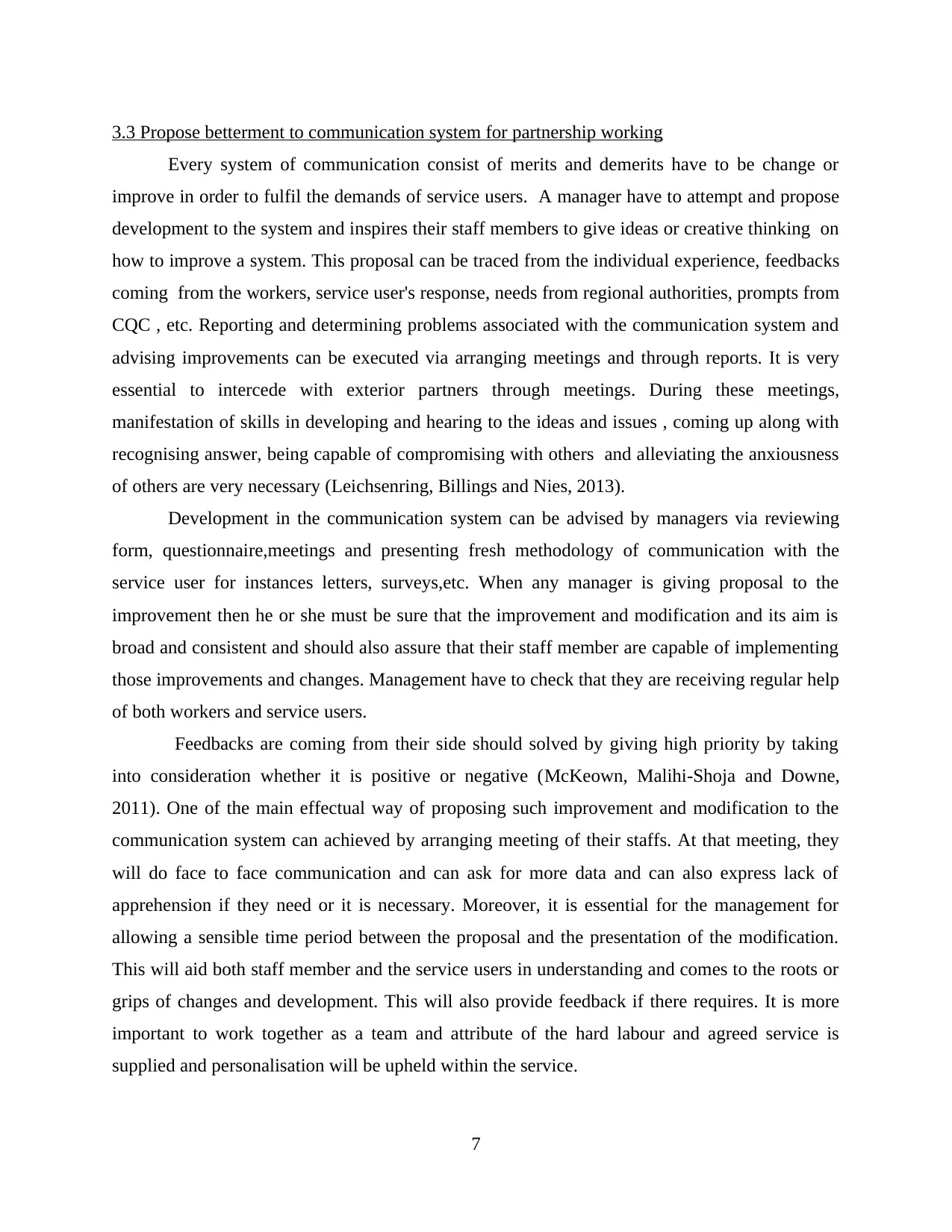
3.3 Propose betterment to communication system for partnership working
Every system of communication consist of merits and demerits have to be change or
improve in order to fulfil the demands of service users. A manager have to attempt and propose
development to the system and inspires their staff members to give ideas or creative thinking on
how to improve a system. This proposal can be traced from the individual experience, feedbacks
coming from the workers, service user's response, needs from regional authorities, prompts from
CQC , etc. Reporting and determining problems associated with the communication system and
advising improvements can be executed via arranging meetings and through reports. It is very
essential to intercede with exterior partners through meetings. During these meetings,
manifestation of skills in developing and hearing to the ideas and issues , coming up along with
recognising answer, being capable of compromising with others and alleviating the anxiousness
of others are very necessary (Leichsenring, Billings and Nies, 2013).
Development in the communication system can be advised by managers via reviewing
form, questionnaire,meetings and presenting fresh methodology of communication with the
service user for instances letters, surveys,etc. When any manager is giving proposal to the
improvement then he or she must be sure that the improvement and modification and its aim is
broad and consistent and should also assure that their staff member are capable of implementing
those improvements and changes. Management have to check that they are receiving regular help
of both workers and service users.
Feedbacks are coming from their side should solved by giving high priority by taking
into consideration whether it is positive or negative (McKeown, Malihi-Shoja and Downe,
2011). One of the main effectual way of proposing such improvement and modification to the
communication system can achieved by arranging meeting of their staffs. At that meeting, they
will do face to face communication and can ask for more data and can also express lack of
apprehension if they need or it is necessary. Moreover, it is essential for the management for
allowing a sensible time period between the proposal and the presentation of the modification.
This will aid both staff member and the service users in understanding and comes to the roots or
grips of changes and development. This will also provide feedback if there requires. It is more
important to work together as a team and attribute of the hard labour and agreed service is
supplied and personalisation will be upheld within the service.
7
Every system of communication consist of merits and demerits have to be change or
improve in order to fulfil the demands of service users. A manager have to attempt and propose
development to the system and inspires their staff members to give ideas or creative thinking on
how to improve a system. This proposal can be traced from the individual experience, feedbacks
coming from the workers, service user's response, needs from regional authorities, prompts from
CQC , etc. Reporting and determining problems associated with the communication system and
advising improvements can be executed via arranging meetings and through reports. It is very
essential to intercede with exterior partners through meetings. During these meetings,
manifestation of skills in developing and hearing to the ideas and issues , coming up along with
recognising answer, being capable of compromising with others and alleviating the anxiousness
of others are very necessary (Leichsenring, Billings and Nies, 2013).
Development in the communication system can be advised by managers via reviewing
form, questionnaire,meetings and presenting fresh methodology of communication with the
service user for instances letters, surveys,etc. When any manager is giving proposal to the
improvement then he or she must be sure that the improvement and modification and its aim is
broad and consistent and should also assure that their staff member are capable of implementing
those improvements and changes. Management have to check that they are receiving regular help
of both workers and service users.
Feedbacks are coming from their side should solved by giving high priority by taking
into consideration whether it is positive or negative (McKeown, Malihi-Shoja and Downe,
2011). One of the main effectual way of proposing such improvement and modification to the
communication system can achieved by arranging meeting of their staffs. At that meeting, they
will do face to face communication and can ask for more data and can also express lack of
apprehension if they need or it is necessary. Moreover, it is essential for the management for
allowing a sensible time period between the proposal and the presentation of the modification.
This will aid both staff member and the service users in understanding and comes to the roots or
grips of changes and development. This will also provide feedback if there requires. It is more
important to work together as a team and attribute of the hard labour and agreed service is
supplied and personalisation will be upheld within the service.
7
Paraphrase This Document
Need a fresh take? Get an instant paraphrase of this document with our AI Paraphraser
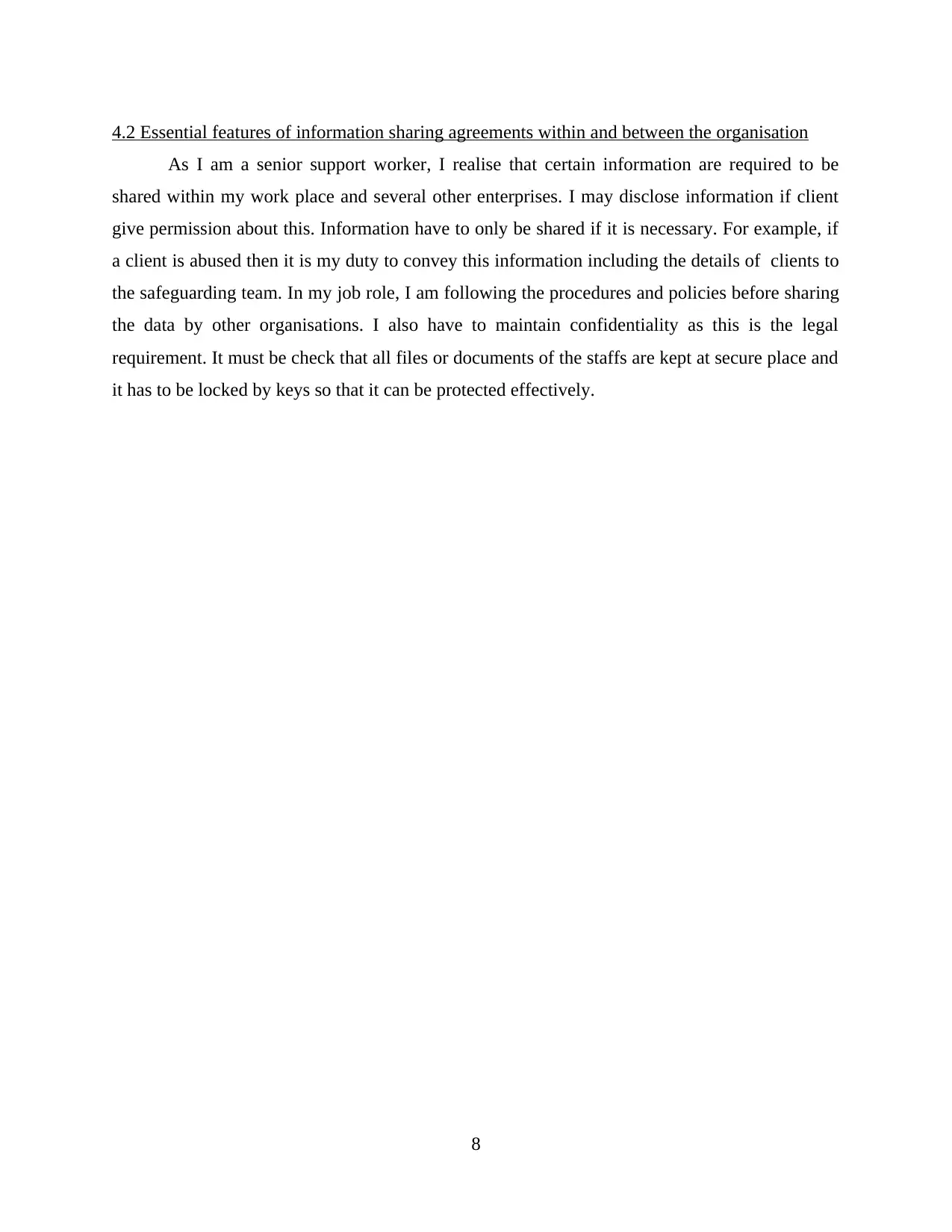
4.2 Essential features of information sharing agreements within and between the organisation
As I am a senior support worker, I realise that certain information are required to be
shared within my work place and several other enterprises. I may disclose information if client
give permission about this. Information have to only be shared if it is necessary. For example, if
a client is abused then it is my duty to convey this information including the details of clients to
the safeguarding team. In my job role, I am following the procedures and policies before sharing
the data by other organisations. I also have to maintain confidentiality as this is the legal
requirement. It must be check that all files or documents of the staffs are kept at secure place and
it has to be locked by keys so that it can be protected effectively.
8
As I am a senior support worker, I realise that certain information are required to be
shared within my work place and several other enterprises. I may disclose information if client
give permission about this. Information have to only be shared if it is necessary. For example, if
a client is abused then it is my duty to convey this information including the details of clients to
the safeguarding team. In my job role, I am following the procedures and policies before sharing
the data by other organisations. I also have to maintain confidentiality as this is the legal
requirement. It must be check that all files or documents of the staffs are kept at secure place and
it has to be locked by keys so that it can be protected effectively.
8
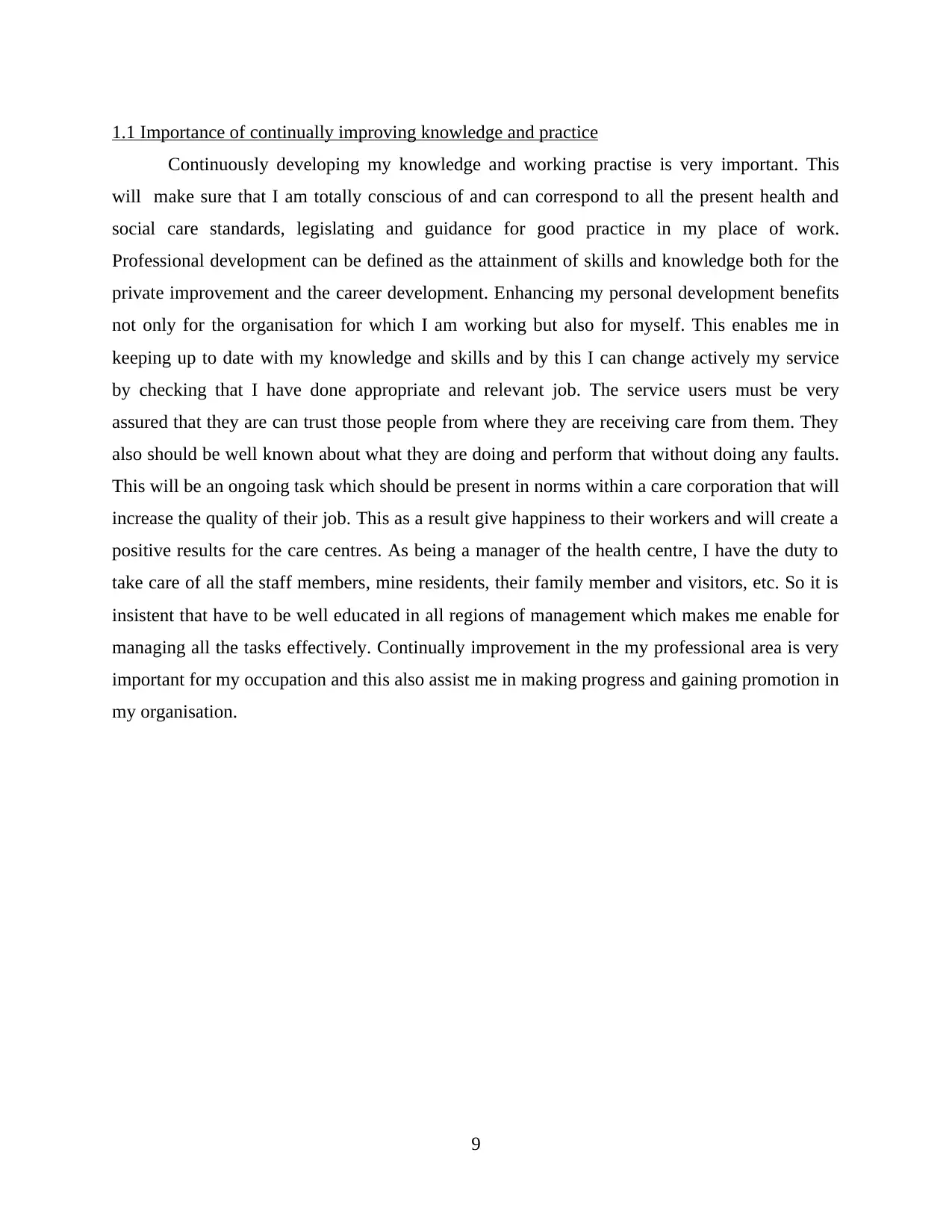
1.1 Importance of continually improving knowledge and practice
Continuously developing my knowledge and working practise is very important. This
will make sure that I am totally conscious of and can correspond to all the present health and
social care standards, legislating and guidance for good practice in my place of work.
Professional development can be defined as the attainment of skills and knowledge both for the
private improvement and the career development. Enhancing my personal development benefits
not only for the organisation for which I am working but also for myself. This enables me in
keeping up to date with my knowledge and skills and by this I can change actively my service
by checking that I have done appropriate and relevant job. The service users must be very
assured that they are can trust those people from where they are receiving care from them. They
also should be well known about what they are doing and perform that without doing any faults.
This will be an ongoing task which should be present in norms within a care corporation that will
increase the quality of their job. This as a result give happiness to their workers and will create a
positive results for the care centres. As being a manager of the health centre, I have the duty to
take care of all the staff members, mine residents, their family member and visitors, etc. So it is
insistent that have to be well educated in all regions of management which makes me enable for
managing all the tasks effectively. Continually improvement in the my professional area is very
important for my occupation and this also assist me in making progress and gaining promotion in
my organisation.
9
Continuously developing my knowledge and working practise is very important. This
will make sure that I am totally conscious of and can correspond to all the present health and
social care standards, legislating and guidance for good practice in my place of work.
Professional development can be defined as the attainment of skills and knowledge both for the
private improvement and the career development. Enhancing my personal development benefits
not only for the organisation for which I am working but also for myself. This enables me in
keeping up to date with my knowledge and skills and by this I can change actively my service
by checking that I have done appropriate and relevant job. The service users must be very
assured that they are can trust those people from where they are receiving care from them. They
also should be well known about what they are doing and perform that without doing any faults.
This will be an ongoing task which should be present in norms within a care corporation that will
increase the quality of their job. This as a result give happiness to their workers and will create a
positive results for the care centres. As being a manager of the health centre, I have the duty to
take care of all the staff members, mine residents, their family member and visitors, etc. So it is
insistent that have to be well educated in all regions of management which makes me enable for
managing all the tasks effectively. Continually improvement in the my professional area is very
important for my occupation and this also assist me in making progress and gaining promotion in
my organisation.
9
⊘ This is a preview!⊘
Do you want full access?
Subscribe today to unlock all pages.

Trusted by 1+ million students worldwide
1 out of 45
Related Documents
Your All-in-One AI-Powered Toolkit for Academic Success.
+13062052269
info@desklib.com
Available 24*7 on WhatsApp / Email
![[object Object]](/_next/static/media/star-bottom.7253800d.svg)
Unlock your academic potential
Copyright © 2020–2025 A2Z Services. All Rights Reserved. Developed and managed by ZUCOL.





